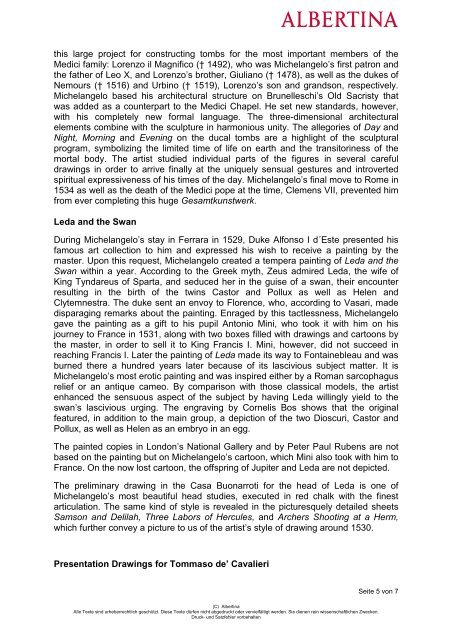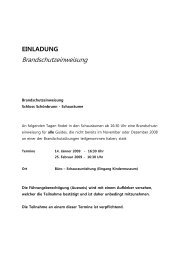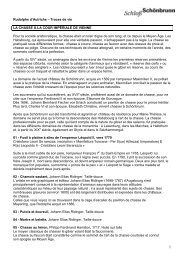Michelangelo. The drawings of a genius - Freizeitbetriebe-wien.at
Michelangelo. The drawings of a genius - Freizeitbetriebe-wien.at
Michelangelo. The drawings of a genius - Freizeitbetriebe-wien.at
You also want an ePaper? Increase the reach of your titles
YUMPU automatically turns print PDFs into web optimized ePapers that Google loves.
this large project for constructing tombs for the most important members <strong>of</strong> the<br />
Medici family: Lorenzo il Magnifico († 1492), who was <strong>Michelangelo</strong>’s first p<strong>at</strong>ron and<br />
the f<strong>at</strong>her <strong>of</strong> Leo X, and Lorenzo’s brother, Giuliano († 1478), as well as the dukes <strong>of</strong><br />
Nemours († 1516) and Urbino († 1519), Lorenzo’s son and grandson, respectively.<br />
<strong>Michelangelo</strong> based his architectural structure on Brunelleschi’s Old Sacristy th<strong>at</strong><br />
was added as a counterpart to the Medici Chapel. He set new standards, however,<br />
with his completely new formal language. <strong>The</strong> three-dimensional architectural<br />
elements combine with the sculpture in harmonious unity. <strong>The</strong> allegories <strong>of</strong> Day and<br />
Night, Morning and Evening on the ducal tombs are a highlight <strong>of</strong> the sculptural<br />
program, symbolizing the limited time <strong>of</strong> life on earth and the transitoriness <strong>of</strong> the<br />
mortal body. <strong>The</strong> artist studied individual parts <strong>of</strong> the figures in several careful<br />
<strong>drawings</strong> in order to arrive finally <strong>at</strong> the uniquely sensual gestures and introverted<br />
spiritual expressiveness <strong>of</strong> his times <strong>of</strong> the day. <strong>Michelangelo</strong>’s final move to Rome in<br />
1534 as well as the de<strong>at</strong>h <strong>of</strong> the Medici pope <strong>at</strong> the time, Clemens VII, prevented him<br />
from ever completing this huge Gesamtkunstwerk.<br />
Leda and the Swan<br />
During <strong>Michelangelo</strong>’s stay in Ferrara in 1529, Duke Alfonso I d´Este presented his<br />
famous art collection to him and expressed his wish to receive a painting by the<br />
master. Upon this request, <strong>Michelangelo</strong> cre<strong>at</strong>ed a tempera painting <strong>of</strong> Leda and the<br />
Swan within a year. According to the Greek myth, Zeus admired Leda, the wife <strong>of</strong><br />
King Tyndareus <strong>of</strong> Sparta, and seduced her in the guise <strong>of</strong> a swan, their encounter<br />
resulting in the birth <strong>of</strong> the twins Castor and Pollux as well as Helen and<br />
Clytemnestra. <strong>The</strong> duke sent an envoy to Florence, who, according to Vasari, made<br />
disparaging remarks about the painting. Enraged by this tactlessness, <strong>Michelangelo</strong><br />
gave the painting as a gift to his pupil Antonio Mini, who took it with him on his<br />
journey to France in 1531, along with two boxes filled with <strong>drawings</strong> and cartoons by<br />
the master, in order to sell it to King Francis I. Mini, however, did not succeed in<br />
reaching Francis I. L<strong>at</strong>er the painting <strong>of</strong> Leda made its way to Fontainebleau and was<br />
burned there a hundred years l<strong>at</strong>er because <strong>of</strong> its lascivious subject m<strong>at</strong>ter. It is<br />
<strong>Michelangelo</strong>’s most erotic painting and was inspired either by a Roman sarcophagus<br />
relief or an antique cameo. By comparison with those classical models, the artist<br />
enhanced the sensuous aspect <strong>of</strong> the subject by having Leda willingly yield to the<br />
swan’s lascivious urging. <strong>The</strong> engraving by Cornelis Bos shows th<strong>at</strong> the original<br />
fe<strong>at</strong>ured, in addition to the main group, a depiction <strong>of</strong> the two Dioscuri, Castor and<br />
Pollux, as well as Helen as an embryo in an egg.<br />
<strong>The</strong> painted copies in London’s N<strong>at</strong>ional Gallery and by Peter Paul Rubens are not<br />
based on the painting but on <strong>Michelangelo</strong>’s cartoon, which Mini also took with him to<br />
France. On the now lost cartoon, the <strong>of</strong>fspring <strong>of</strong> Jupiter and Leda are not depicted.<br />
<strong>The</strong> preliminary drawing in the Casa Buonarroti for the head <strong>of</strong> Leda is one <strong>of</strong><br />
<strong>Michelangelo</strong>’s most beautiful head studies, executed in red chalk with the finest<br />
articul<strong>at</strong>ion. <strong>The</strong> same kind <strong>of</strong> style is revealed in the picturesquely detailed sheets<br />
Samson and Delilah, Three Labors <strong>of</strong> Hercules, and Archers Shooting <strong>at</strong> a Herm,<br />
which further convey a picture to us <strong>of</strong> the artist’s style <strong>of</strong> drawing around 1530.<br />
Present<strong>at</strong>ion Drawings for Tommaso de’ Cavalieri<br />
Seite 5 von 7<br />
(C) Albertina<br />
Alle Texte sind urheberrechtlich geschützt. Diese Texte dürfen nicht abgedruckt oder vervielfältigt werden. Sie dienen rein wissenschaftlichen Zwecken.<br />
Druck- und S<strong>at</strong>zfehler vorbehalten
















